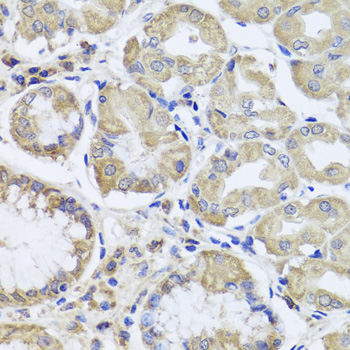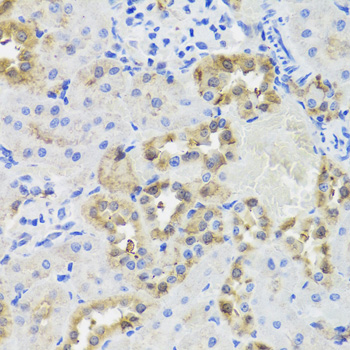Immunology Antibodies 2
Anti-JAK2 Antibody (CAB7694)
- SKU:
- CAB7694
- Product Type:
- Antibody
- Reactivity:
- Human
- Reactivity:
- Mouse
- Reactivity:
- Rat
- Host Species:
- Rabbit
- Isotype:
- IgG
- Antibody Type:
- Polyclonal Antibody
- Research Area:
- Immunology
Description
| Antibody Name: | Anti-JAK2 Antibody |
| Antibody SKU: | CAB7694 |
| Antibody Size: | 20uL, 50uL, 100uL |
| Application: | WB IHC |
| Reactivity: | Human, Mouse, Rat |
| Host Species: | Rabbit |
| Immunogen: | A synthetic peptide of human JAK2 |
| Application: | WB IHC |
| Recommended Dilution: | WB 1:500 - 1:1000 IHC 1:50 - 1:100 |
| Reactivity: | Human, Mouse, Rat |
| Positive Samples: | MCF7, Jurkat, Mouse liver |
| Immunogen: | A synthetic peptide of human JAK2 |
| Purification Method: | Affinity purification |
| Storage Buffer: | Store at -20'C. Avoid freeze / thaw cycles. Buffer: PBS with 0.02% sodium azide, 50% glycerol, pH7.3. |
| Isotype: | IgG |
| Sequence: | Email for sequence |
| Gene ID: | 3717 |
| Uniprot: | O60674 |
| Cellular Location: | Cytoplasm, Endomembrane system, Nucleus, Peripheral membrane protein |
| Calculated MW: | 130kDa |
| Observed MW: | 115kDa |
| Synonyms: | JAK2, JTK10, THCYT3 |
| Background: | This gene product is a protein tyrosine kinase involved in a specific subset of cytokine receptor signaling pathways. It has been found to be constituitively associated with the prolactin receptor and is required for responses to gamma interferon. Mice that do not express an active protein for this gene exhibit embryonic lethality associated with the absence of definitive erythropoiesis. |
| UniProt Protein Function: | JAK2: a non-receptor tyrosine-kinase involved in a specific subset of cytokine receptor signaling pathways, including IL-3, -5 and GM-CSF. Interacts with IL23R, SKB1 and STAM2. It has been found to be constitutively associated with the prolactin receptor and is required for responses to gamma interferon. Mice that do not express an active protein for this gene exhibit embryonic lethality associated with the absence of definitive erythropoiesis. Fusion of Jak2 to TEL1 (ETV6) by t(9;12)(p24;p13) causes myeloproliferative disease in humans and mouse models. The Jak inhibitor AG490 inhibits constitutive Jak2 phosphorylation and causes apoptosis in cells from breast cancer and relapsing acute lymphoblastic leukemia. A single activating mutation is associated with several hematological malignancies. Inhibitor: AG490. |
| UniProt Protein Details: | Protein type:Protein kinase, TK; EC 2.7.10.2; Kinase, protein; Oncoprotein; Protein kinase, tyrosine (non-receptor); TK group; JakA family Chromosomal Location of Human Ortholog: 9p24 Cellular Component: caveola; cytoplasm; cytoskeleton; cytosol; extrinsic to internal side of plasma membrane; lipid raft; nuclear matrix; nucleoplasm; nucleus Molecular Function:acetylcholine receptor binding; ATP binding; growth hormone receptor binding; heme binding; histone binding; insulin receptor substrate binding; interleukin-12 receptor binding; metal ion binding; non-membrane spanning protein tyrosine kinase activity; peptide hormone receptor binding; phosphoinositide 3-kinase binding; protein binding; protein C-terminus binding; protein kinase activity; protein kinase binding; protein-tyrosine kinase activity; Ras guanyl-nucleotide exchange factor activity; receptor binding; SH2 domain binding; type 1 angiotensin receptor binding Biological Process: actin filament polymerization; activation of MAPKK activity; adaptive immune response; apoptosis; axon regeneration; blood coagulation; caspase activation; cell differentiation; cell migration; cell motility; cytokine and chemokine mediated signaling pathway; elevation of cytosolic calcium ion concentration; enzyme linked receptor protein signaling pathway; erythrocyte differentiation; G-protein coupled receptor protein signaling pathway; induction of apoptosis by oxidative stress; innate immune response; JAK-STAT cascade; MAPKKK cascade; mesoderm development; mineralocorticoid receptor signaling pathway; negative regulation of cell proliferation; negative regulation of cell-cell adhesion; negative regulation of DNA binding; negative regulation of heart contraction; negative regulation of neuron apoptosis; peptidyl-tyrosine phosphorylation; platelet-derived growth factor receptor signaling pathway; positive regulation of cell activation; positive regulation of cell differentiation; positive regulation of cell migration; positive regulation of cell proliferation; positive regulation of DNA binding; positive regulation of GTPase activity; positive regulation of inflammatory response; positive regulation of insulin secretion; positive regulation of interleukin-1 beta production; positive regulation of nitric oxide biosynthetic process; positive regulation of nitric-oxide synthase biosynthetic process; positive regulation of peptidyl-tyrosine phosphorylation; positive regulation of phosphoinositide 3-kinase cascade; positive regulation of phosphoprotein phosphatase activity; positive regulation of protein import into nucleus, translocation; positive regulation of transcription factor activity; positive regulation of tumor necrosis factor production; positive regulation of tyrosine phosphorylation of Stat3 protein; positive regulation of tyrosine phosphorylation of Stat5 protein; protein amino acid autophosphorylation; protein amino acid phosphorylation; regulation of apoptosis; regulation of cell proliferation; regulation of inflammatory response; response to antibiotic; response to hydroperoxide; response to lipopolysaccharide; signal transduction; STAT protein nuclear translocation; tumor necrosis factor-mediated signaling pathway; tyrosine phosphorylation of JAK2 protein; tyrosine phosphorylation of STAT protein; tyrosine phosphorylation of Stat1 protein; tyrosine phosphorylation of Stat3 protein; tyrosine phosphorylation of Stat5 protein Disease: Budd-chiari Syndrome; Erythrocytosis, Familial, 1; Myelofibrosis; Polycythemia Vera; Thrombocythemia 3 |
| NCBI Summary: | This gene product is a protein tyrosine kinase involved in a specific subset of cytokine receptor signaling pathways. It has been found to be constituitively associated with the prolactin receptor and is required for responses to gamma interferon. Mice that do not express an active protein for this gene exhibit embryonic lethality associated with the absence of definitive erythropoiesis. [provided by RefSeq, Jul 2008] |
| UniProt Code: | O60674 |
| NCBI GenInfo Identifier: | 12643404 |
| NCBI Gene ID: | 3717 |
| NCBI Accession: | O60674.2 |
| UniProt Secondary Accession: | O60674,O14636, O75297, |
| UniProt Related Accession: | O60674 |
| Molecular Weight: | 130,674 Da |
| NCBI Full Name: | Tyrosine-protein kinase JAK2 |
| NCBI Synonym Full Names: | Janus kinase 2 |
| NCBI Official Symbol: | JAK2 |
| NCBI Official Synonym Symbols: | JTK10; THCYT3 |
| NCBI Protein Information: | tyrosine-protein kinase JAK2 |
| UniProt Protein Name: | Tyrosine-protein kinase JAK2 |
| UniProt Synonym Protein Names: | Janus kinase 2; JAK-2 |
| Protein Family: | Tyrosine-protein kinase |
| UniProt Gene Name: | JAK2 |
| UniProt Entry Name: | JAK2_HUMAN |









